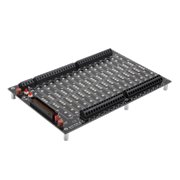 For more robust SNAP PAC system sensing and switching.
For more robust SNAP PAC system sensing and switching.
Use a SNAP TEX breakout board to expand the capability of your SNAP high-density digital (HDD) I/O modules. The SNAP-UDC-HDB-G4 breakout board holds up to 32 G4 digital input or output modules to match the SNAP HDD input or output module you have. You get the 3 amp per channel ability of the G4 where you need it, mixed in with analog, digital, and serial modules on a compact SNAP PAC rack.